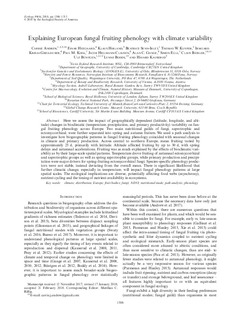| dc.contributor.author | Andrew, Carrie Joy | |
| dc.contributor.author | Heegaard, Einar | |
| dc.contributor.author | Høiland, Klaus | |
| dc.contributor.author | Senn-Irlet, Beatrice | |
| dc.contributor.author | Kuyper, Thomas W. | |
| dc.contributor.author | Krisai-Greilhuber, Irmgard | |
| dc.contributor.author | Kirk, Paul M. | |
| dc.contributor.author | Heilmann-Clausen, Jacob | |
| dc.contributor.author | Gange, Alan C. | |
| dc.contributor.author | Egli, Simon | |
| dc.contributor.author | Bässler, Claus | |
| dc.contributor.author | Büntgen, Ulf | |
| dc.contributor.author | Boddy, Lynne | |
| dc.contributor.author | Kauserud, Håvard | |
| dc.date.accessioned | 2019-03-18T11:39:03Z | |
| dc.date.available | 2019-03-18T11:39:03Z | |
| dc.date.created | 2018-07-09T15:14:24Z | |
| dc.date.issued | 2018-04-14 | |
| dc.identifier.citation | Ecology. 2018, 99 (6), 1306-1315. | nb_NO |
| dc.identifier.issn | 0012-9658 | |
| dc.identifier.uri | http://hdl.handle.net/11250/2590454 | |
| dc.description.abstract | Here we assess the impact of geographically dependent (latitude, longitude, and alti-tude) changes in bioclimatic (temperature, precipitation, and primary productivity) variability on fun-gal fruiting phenology across Europe. Two main nutritional guilds of fungi, saprotrophic andectomycorrhizal, were further separated into spring and autumn fruiters. We used a path analysis toinvestigate how biogeographic patterns in fungal fruiting phenology coincided with seasonal changesin climate and primary production. Across central to northern Europe, mean fruiting varied byapproximately 25 d, primarily with latitude. Altitude affected fruiting by up to 30 d, with springdelays and autumnal accelerations. Fruiting was as much explained by the effects of bioclimatic vari-ability as by their large-scale spatial patterns. Temperature drove fruiting of autumnal ectomycorrhizaland saprotrophic groups as well as spring saprotrophic groups, while primary production and precipi-tation were major drivers for spring-fruiting ectomycorrhizal fungi. Species-specific phenology predic-tors were not stable, instead deviating from the overall mean. There is significant likelihood thatfurther climatic change, especially in temperature, will impact fungal phenology patterns at largespatial scales. The ecological implications are diverse, potentially affecting food webs (asynchrony),nutrient cycling and the timing of nutrient availability in ecosystems. | nb_NO |
| dc.language.iso | eng | nb_NO |
| dc.subject | Climate | nb_NO |
| dc.subject | Distribution | nb_NO |
| dc.subject | Fruit bodies | nb_NO |
| dc.subject | Fungi | nb_NO |
| dc.subject | NDVI | nb_NO |
| dc.subject | Nutritional mode | nb_NO |
| dc.subject | Path analysis | nb_NO |
| dc.subject | Phenology | nb_NO |
| dc.title | Explaining European fungal fruiting phenology with climate variability | nb_NO |
| dc.type | Journal article | nb_NO |
| dc.type | Peer reviewed | nb_NO |
| dc.description.version | publishedVersion | nb_NO |
| dc.rights.holder | © 2018 by the Ecological Society of America | nb_NO |
| dc.subject.nsi | VDP::Matematikk og Naturvitenskap: 400::Geofag: 450 | nb_NO |
| dc.subject.nsi | VDP::Landbruks- og Fiskerifag: 900 | nb_NO |
| dc.source.pagenumber | 1306-1315 | nb_NO |
| dc.source.volume | 99 | nb_NO |
| dc.source.journal | Ecology | nb_NO |
| dc.source.issue | 6 | nb_NO |
| dc.identifier.doi | 10.1002/ecy.2237 | |
| dc.identifier.cristin | 1596405 | |
| dc.relation.project | Norges forskningsråd 225043 | nb_NO |
| cristin.ispublished | true | |
| cristin.fulltext | original | |
| cristin.qualitycode | 2 | |
